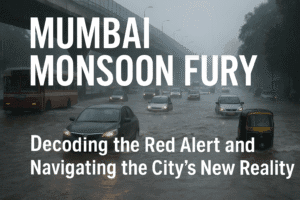Mumbai Monsoon Fury: Decoding the Red Alert and Navigating the City’s New Reality
Mumbai was plunged into chaos after the IMD issued a red alert, signaling extreme and potentially life-threatening rainfall. The city’s infrastructure struggled to cope, with severe waterlogging paralyzing key areas like the Western Express Highway and forcing the closure of the Andheri Subway. This event triggered a cascade of disruptions, leading to widespread traffic gridlock and prompting airlines to issue travel advisories due to inaccessible airport roads.
The crisis underscores a deeper vulnerability, as the city’s aging drainage system is consistently overwhelmed by these intense cloudbursts. While immediate civic action, including school closures, helped mitigate risk, the situation highlights an urgent need for long-term climate-resilient urban planning. Ultimately, the event serves as a stark reminder of the delicate balance between urban life and powerful natural forces, demanding both systemic upgrades and informed citizen preparedness for this new reality.

Mumbai Monsoon Fury: Decoding the Red Alert and Navigating the City’s New Reality
The familiar drumming of torrential rain on windows returned with a vengeance to Mumbai on Monday, but this was no ordinary monsoon shower. The India Meteorological Department’s (IMD) stark red alert—signifying “extremely heavy rainfall”—transformed the city’s bustling rhythm into a cautious, waterlogged struggle. The scenes were hauntingly familiar: the Western Express Highway slowed to a crawl, the Gandhi Market in Sion submerged, and the Andheri Subway, a critical arterial road, closed indefinitely.
Yet, beyond the headlines of traffic chaos and school closures lies a deeper story about what it means to live in, and prepare for, the new normal of urban extreme weather.
Beyond the Headlines: What a “Red Alert” Truly Means
A red alert is the IMD’s highest warning level. It’s not just a suggestion to carry an umbrella; it’s an urgent directive that conditions are dangerous and life-threatening. The data from just a few hours on Monday morning paints a clear picture:
- Tata Power, Chembur: 91.5 mm
- Vikhroli: 78.5 mm
- Juhu: 60.0 mm
To put this in perspective, some areas received nearly a tenth of their average annual rainfall in a matter of hours. This isn’t rain; it’s a massive volume of water attempting to flow through a complex, often overwhelmed, urban system.
The Ripple Effect: More Than Just Water on Roads
The impact of such an event cascades through the city like the floodwaters themselves.
- The Commuter’s Nightmare: The traffic snarls aren’t just an inconvenience. For emergency services, every delayed minute can be critical. The advisories from airlines like Akasa Air and IndiGo highlight a less-obvious consequence: the airport, a global transit hub, is isolated by its flooded access roads, causing a domino effect on travel plans nationwide.
- The Economic Toll: When Mumbai sneezes, India’s economy catches a cold. The forced closure of schools and businesses, the delays in logistics and supply chains, and the damage to infrastructure and property represent a significant economic setback that lasts long after the water recedes.
- The Human Factor: Behind every statistic is a person—a parent anxiously waiting for a school bus, a small shop owner watching inventory get damaged, or a team of BMC workers and local volunteers risking their safety to clear drains and rescue stranded motorists.
Expert Insight: This Isn’t Just About the Rain
While the immediate trigger is a severe weather system, urban planners point to a chronic underlying condition: the city’s strained drainage capacity. Mumbai’s century-old stormwater drain system, designed for a different era of rainfall intensity and urban sprawl, is simply not built for these cloudburst-level events. Concretization has replaced natural absorbent surfaces, forcing water to run off rather than seep in, overwhelming the system instantly.
The BMC’s declaration of a holiday and the activation of emergency protocols is a well-rehearsed drill, a testament to the hard lessons learned from past tragedies like the 2005 deluge. The real test, however, is in long-term adaptation—investing in sustainable drainage solutions, preserving mangroves that act as natural buffers, and rethinking urban development to be more resilient.
A Citizen’s Guide to Navigating a Red Alert
Instead of just advising “avoid stepping out,” here’s a actionable checklist for Mumbaikars:
- Before You Travel: Check real-time traffic on apps like Google Maps or local Twitter handles. Heed airline advisories and leave for the airport with a minimum 2-hour buffer.
- Build a “Go-Bag”: Keep a small kit ready with a power bank, bottled water, dry snacks, a first-aid kit, and important documents in a waterproof pouch.
- Know Your Resources: Save the BMC helpline (1916) and local ward office numbers in your phone. Rely on official sources like the IMD and BMC Twitter handles for updates, not unverified forwards.
- Never Underestimate Water: A foot of moving water can sweep away a car. The mantra “Turn Around, Don’t Drown” is a lifesaver. Avoid walking or driving through flooded streets.
The Road Ahead
The rains will eventually subside, the water will drain, and Mumbai will bounce back with its characteristic spirit. But each red alert is a stark reminder. It’s a call to action for civic authorities to accelerate climate-resilient infrastructure and for every citizen to move from reactive fear to proactive preparedness. The true strength of this maximum city is not just in enduring the storm, but in learning how to build a more resilient haven within it.
You must be logged in to post a comment.